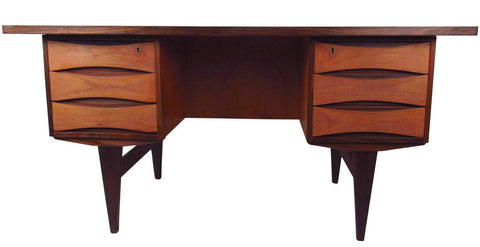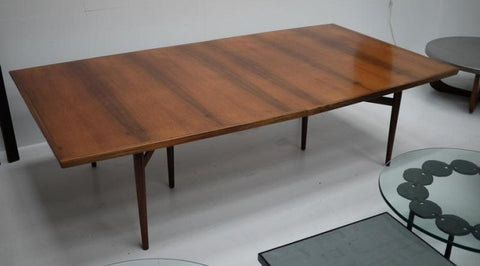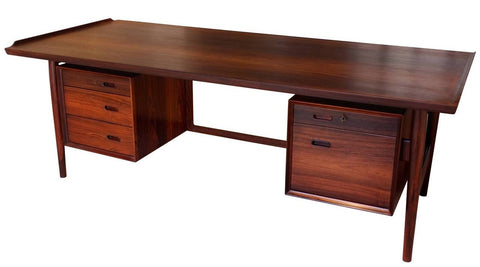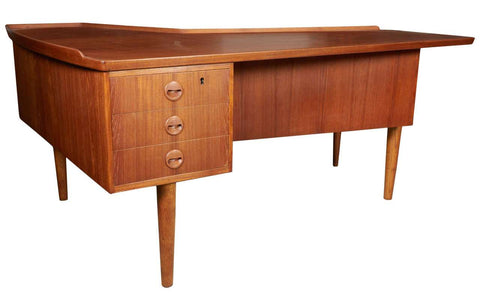Great Danish Designers 101: Arne Vodder
In 2009, Arne Vodder was asked what good design meant to him. He replied that a design must be useful and aesthetically beautiful. His very simple reply summarized the entire aesthetic of Danish mid-century design, which focused on maximizing function while also creating objects that were, in Vodder’s words, “beautiful to look at, with curves and organic forms.” Although lesser known than some of his contemporaries, Vodder succeeded in marrying form and function, creating practical designs known for being handsome and “simple, but noble.” (ScandianvianMod.com)
Arne Vodder: A Long and Varied Career
Arne Vodder was part of the “second generation” of Danish furniture designers. Born in 1926, he trained as a cabinetmaker and architect, studying under Finn Juhl at the Royal Danish Academy of Fine Arts in Copenhagen. After graduating in 1947, Vodder enjoyed a long and diverse career, keeping a hand in both furniture design and architecture.
Immediately following his graduation, he worked as a designer of office décor with Findsgaul in Copenhagen. He established his own design and architecture firm with architect Anton Borg in 1950. Together, Vodder and Borg designed furniture and more than 1,100 low-cost houses.
As an architect, in addition to his work with Borg, Vodder spent 25 years designing interiors with department store Havemann’s Magasiner A/S. As a designer, Vodder worked with many furniture manufacturers—including Fritz Hansen, France & Son, Cado, and Bovirke—but it was his work with Sibast that brought him the most attention. With Sibast he created desks, tables, chairs, and cabinets used mainly in offices.
His partnership with Borg ended in 1975, but Vodder kept working as a designer. In the mid-1970s he partnered with manufacturer Erik Jørgensen, for whom he created several armchairs and easy chairs. In the 1980s he designed garden furniture with Kirkodan and worked on new designs for lacquered furniture with InterForm Collection and Xcol. In the 1990s he joined with Nilaus Furniture to create reproductions of Fritz Hansen designs. By 2006, it was Vodder’s designs that were being reproduced, in limited numbers, in response to growing consumer interest in his sideboards and dressers. Vodder passed away in 2009. (arnevodder.dk, 1stdibs, pamono.ca)
Vodder’s Iconic Sideboard
According to Scandinavian Modern, the sideboards and desks Vodder designed for Sibast were his most “beautiful and desired objects.” This is an assessment with which Vodder seemed to agree. When asked in 2009 to choose a favourite among his many designs, Vodder selected the Model 29 sideboard. The now iconic piece featured drawers shaped to avoid the need for handles. It also showcased the asymmetry with which Vodder often experimented. In the Model 29, the curves of the drawers provide a counterbalance to the rectangular doors:
Image from RetroStart.
The design elements apparent in the Model 29 sideboard appeared in other pieces designed for the home, including Vodder’s hall furniture, dressers, and desks.
Vodder’s rosewood hall set also shows the asymmetry that appealed to him, with the tall mirror offset by a compact set of drawers with handles similar to those on the Model 29.
Image from 1stdibs.
Yet symmetry was not completely absent from Vodder’s designs. The dresser below is all symmetry, with each drawer perfectly balanced and seeming to flow into the next.
Walnut Commode, Image from 1stdibs.
Also beautifully balanced, this Vodder desk combines teak and rosewood for added visual interest.
Image from 1stdibs.
This mixing of woods was very typical of mid-century Danish designers who used imported, durable hardwoods in all of their pieces. Combining contrasting woods like teak and rosewood enabled them to create the illusion of added depth.
Colour was another hallmark of Danish mid-century design. As we have noted in previous posts in this series, Scandinavian designers used bold colours to add “domestic cheer” to rooms that could feel quite dark in the long winter season. As a designer of business and residential furniture, Vodder knew exactly when and where to use colour. For the home, he created bold designs with bright lacquer accents, as seen in a different version of the Model 29 which he enlivened with bright yellow:
Image from pamono.ca.
In the dresser below, Vodder combined dark rosewood with bright blue lacquer.
Image from 1stdibs.
And in one of his better known designs, he used multiple colours to brighten a desk and sideboard combination.
Image from pamona.ca.
On the business side, Vodder was more conservative. In fact, as a designer, he was keenly aware of the intended uses of his furniture, and was known for maintaining “sobriety in the boardroom [and] playfulness at home.” (1stdibs.com)This is likely the reason that his designs were chosen for such august locations as the United Nations Office in Geneva, President Jimmy Carter’s White House, and various embassies around the world. One could certainly imagine pieces like this rosewood conference table or “President desk” in such places:
Image from designaddict.com.
Image from 1stdibs.
But for the busy executive who conducted business far differently from the way it is done today, another option in office furniture: a desk with built-in bar that, again, features the asymmetrical lines Vodder loved.
Images from 1stdibs.
Like all mid-century designers, Vodder did not limit himself to one particular type of furniture or iconic design. He was also known for his seating. On the domestic front, the chaise longue he designed for Erik Jørgensen stands out. It is evident just from looking at the chair that it was designed to follow the contours of the body, providing comfort while also looking beautiful itself.
Image from designaddict.com.
An article in Wallpaper magazine noted that the chaise longue was the “first item to be designed by Vodder with a full metal frame in matte steel and cast in the synthetic material ‘ironside.’” With these materials, Vodder was clearly showing an experimental side not uncommon among Danish designers who often incorporated modern materials into their work. The chaise longue was first designed and produced in 1972 but, as recently reported in the Wallpaper article, Erik Jørgensen began remaking the chair this year.
In his other seating, whether for the dining room or office, Vodder was known for creations that were “quiet in form—projecting an air of sturdiness and strength, rather than avant-garde styling.” (1stdibs) The model 431 is a particularly stunning example of these traits:
Image from scandinavianmod.com.
The Model 431 chair was suited for business and home, and showed the “quiet form” and excellent craftsmanship for which Vodder was known. His easy chairs and dining chairs, some of which are shown below, had a similar aesthetic and are much sought after today.
All images from 1stdibs.com.
The final word on Vodder comes from the man himself, through the interview he gave before his death in 2009. He was asked why his furniture was still popular. His answer is a perfect summary of his creative output. He talked about the timelessness of the designs and noted that people appreciate “that there is thought about the quality, and it does not look factory produced, but looks like real craftsmanship. Organic, aesthetic and beautifully created.”




















Leave a comment